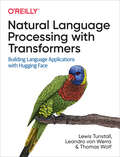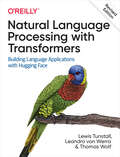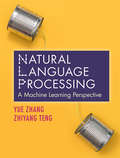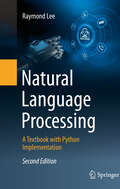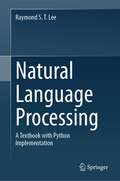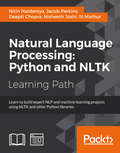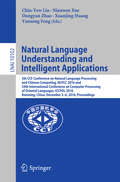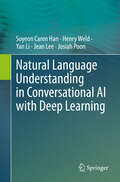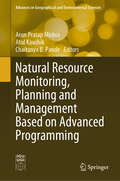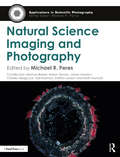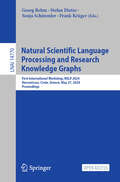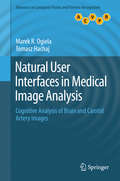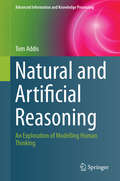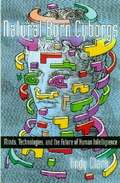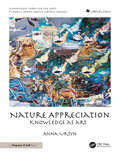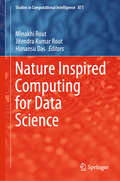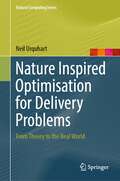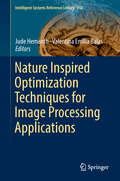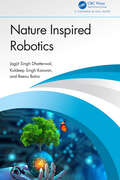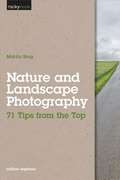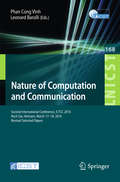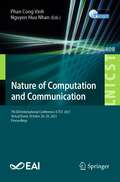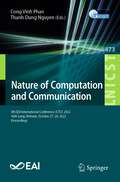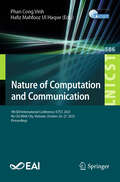- Table View
- List View
Natural Language Processing with Transformers
by Thomas Wolf Lewis Tunstall Leandro Von WerraSince their introduction in 2017, transformers have quickly become the dominant architecture for achieving state-of-the-art results on a variety of natural language processing tasks. If you're a data scientist or coder, this practical book shows you how to train and scale these large models using Hugging Face Transformers, a Python-based deep learning library.Transformers have been used to write realistic news stories, improve Google Search queries, and even create chatbots that tell corny jokes. In this guide, authors Lewis Tunstall, Leandro von Werra, and Thomas Wolf, among the creators of Hugging Face Transformers, use a hands-on approach to teach you how transformers work and how to integrate them in your applications. You'll quickly learn a variety of tasks they can help you solve.Build, debug, and optimize transformer models for core NLP tasks, such as text classification, named entity recognition, and question answeringLearn how transformers can be used for cross-lingual transfer learningApply transformers in real-world scenarios where labeled data is scarceMake transformer models efficient for deployment using techniques such as distillation, pruning, and quantizationTrain transformers from scratch and learn how to scale to multiple GPUs and distributed environments
Natural Language Processing with Transformers, Revised Edition
by Thomas Wolf Lewis Tunstall Leandro Von WerraSince their introduction in 2017, transformers have quickly become the dominant architecture for achieving state-of-the-art results on a variety of natural language processing tasks. If you're a data scientist or coder, this practical book -now revised in full color- shows you how to train and scale these large models using Hugging Face Transformers, a Python-based deep learning library.Transformers have been used to write realistic news stories, improve Google Search queries, and even create chatbots that tell corny jokes. In this guide, authors Lewis Tunstall, Leandro von Werra, and Thomas Wolf, among the creators of Hugging Face Transformers, use a hands-on approach to teach you how transformers work and how to integrate them in your applications. You'll quickly learn a variety of tasks they can help you solve.Build, debug, and optimize transformer models for core NLP tasks, such as text classification, named entity recognition, and question answeringLearn how transformers can be used for cross-lingual transfer learningApply transformers in real-world scenarios where labeled data is scarceMake transformer models efficient for deployment using techniques such as distillation, pruning, and quantizationTrain transformers from scratch and learn how to scale to multiple GPUs and distributed environments
Natural Language Processing: A Machine Learning Perspective
by Yue Zhang Zhiyang TengWith a machine learning approach and less focus on linguistic details, this gentle introduction to natural language processing develops fundamental mathematical and deep learning models for NLP under a unified framework. NLP problems are systematically organised by their machine learning nature, including classification, sequence labelling, and sequence-to-sequence problems. Topics covered include statistical machine learning and deep learning models, text classification and structured prediction models, generative and discriminative models, supervised and unsupervised learning with latent variables, neural networks, and transition-based methods. Rich connections are drawn between concepts throughout the book, equipping students with the tools needed to establish a deep understanding of NLP solutions, adapt existing models, and confidently develop innovative models of their own. Featuring a host of examples, intuition, and end of chapter exercises, plus sample code available as an online resource, this textbook is an invaluable tool for the upper undergraduate and graduate student.
Natural Language Processing: A Textbook with Python Implementation
by Raymond LeeThis textbook provides a contemporary and comprehensive overview of Natural Language Processing (NLP), covering fundamental concepts, core algorithms, and key applications such as AI chatbots, Large Language Models and Generative AI. Additionally, it includes seven step-by-step NLP workshops, totaling 14 hours, that offer hands-on practice with essential Python tools, including NLTK, spaCy, TensorFlow, Keras, Transformers, and BERT. The objective of this book is to provide readers with a fundamental grasp of NLP and its core technologies, and to enable them to build their own NLP applications (e.g. Chatbot systems) using Python-based NLP tools. It is both a textbook and NLP tool-book intended for the following readers: undergraduate students from various disciplines who want to learn NLP; lecturers and tutors who want to teach courses or tutorials for undergraduate/graduate students on NLP and related AI topics; and readers with various backgrounds who want to learn NLP, and more importantly, to build workable NLP applications after completing its 14 hours of Python-based workshops.
Natural Language Processing: A Textbook with Python Implementation
by Raymond S. LeeThis textbook presents an up-to-date and comprehensive overview of Natural Language Processing (NLP), from basic concepts to core algorithms and key applications. Further, it contains seven step-by-step NLP workshops (total length: 14 hours) offering hands-on practice with essential Python tools like NLTK, spaCy, TensorFlow Kera, Transformer and BERT.The objective of this book is to provide readers with a fundamental grasp of NLP and its core technologies, and to enable them to build their own NLP applications (e.g. Chatbot systems) using Python-based NLP tools. It is both a textbook and NLP tool-book intended for the following readers: undergraduate students from various disciplines who want to learn NLP; lecturers and tutors who want to teach courses or tutorials for undergraduate/graduate students on NLP and related AI topics; and readers with various backgrounds who want to learn NLP, and more importantly, to build workable NLP applications after completing its 14 hours of Python-based workshops.
Natural Language Processing: Python and NLTK
by Jacob Perkins Nitin Hardeniya Nisheeth Joshi Deepti Chopra Iti MathurLearn to build expert NLP and machine learning projects using NLTK and other Python libraries About This Book * Break text down into its component parts for spelling correction, feature extraction, and phrase transformation * Work through NLP concepts with simple and easy-to-follow programming recipes * Gain insights into the current and budding research topics of NLP Who This Book Is For If you are an NLP or machine learning enthusiast and an intermediate Python programmer who wants to quickly master NLTK for natural language processing, then this Learning Path will do you a lot of good. Students of linguistics and semantic/sentiment analysis professionals will find it invaluable. What You Will Learn * The scope of natural language complexity and how they are processed by machines * Clean and wrangle text using tokenization and chunking to help you process data better * Tokenize text into sentences and sentences into words * Classify text and perform sentiment analysis * Implement string matching algorithms and normalization techniques * Understand and implement the concepts of information retrieval and text summarization * Find out how to implement various NLP tasks in Python In Detail Natural Language Processing is a field of computational linguistics and artificial intelligence that deals with human-computer interaction. It provides a seamless interaction between computers and human beings and gives computers the ability to understand human speech with the help of machine learning. The number of human-computer interaction instances are increasing so it's becoming imperative that computers comprehend all major natural languages. The first NLTK Essentials module is an introduction on how to build systems around NLP, with a focus on how to create a customized tokenizer and parser from scratch. You will learn essential concepts of NLP, be given practical insight into open source tool and libraries available in Python, shown how to analyze social media sites, and be given tools to deal with large scale text. This module also provides a workaround using some of the amazing capabilities of Python libraries such as NLTK, scikit-learn, pandas, and NumPy. The second Python 3 Text Processing with NLTK 3 Cookbook module teaches you the essential techniques of text and language processing with simple, straightforward examples. This includes organizing text corpora, creating your own custom corpus, text classification with a focus on sentiment analysis, and distributed text processing methods. The third Mastering Natural Language Processing with Python module will help you become an expert and assist you in creating your own NLP projects using NLTK. You will be guided through model development with machine learning tools, shown how to create training data, and given insight into the best practices for designing and building NLP-based applications using Python. This Learning Path combines some of the best that Packt has to offer in one complete, curated package and is designed to help you quickly learn text processing with Python and NLTK. It includes content from the following Packt products: * NTLK essentials by Nitin Hardeniya * Python 3 Text Processing with NLTK 3 Cookbook by Jacob Perkins * Mastering Natural Language Processing with Python by Deepti Chopra, Nisheeth Joshi, and Iti Mathur Style and approach This comprehensive course creates a smooth learning path that teaches you how to get started with Natural Language Processing using Python and NLTK. You'll learn to create effective NLP and machine learning projects using Python and NLTK.
Natural Language Understanding and Intelligent Applications
by Dongyan Zhao Xuanjing Huang Chin-Yew Lin Nianwen Xue Yansong FengThis book constitutes the joint refereed proceedings of the 5th CCF Conference on Natural Language Processing and Chinese Computing, NLPCC 2016, and the 24th International Conference on Computer Processing of Oriental Languages, ICCPOL 2016, held in Kunming, China, in December 2016. The 48 revised full papers presented together with 41 short papers were carefully reviewed and selected from 216 submissions. The papers cover fundamental research in language computing, multi-lingual access, web mining/text mining, machine learning for NLP, knowledge graph, NLP for social network, as well as applications in language computing.
Natural Language Understanding in Conversational AI with Deep Learning
by Yan Li Josiah Poon Soyeon Caren Han Henry Weld Jean LeeThis book provides a comprehensive introduction to conversational spoken language understanding and surveys recent advances in conversational AI. It guides the reader through the history, current advancements, and future of natural language understanding (NLU) in human-computer interactions. To this end, the book is structured in seven chapters: Introduction to Natural Language Understanding lays the foundation by tracing the evolution of NLU from early human communication to modern human-computer interactions. Prerequisites and Glossary for Natural Language Understanding then serves as a foundational resource, consolidating essential prerequisites and key terminologies relevant across the book. Single-Turn Natural Language Understanding looks at Single-Turn NLU, focusing on tasks that involve interpreting and processing user inputs in a single interaction, while Multi-Turn Natural Language Understanding moves on systems for extended interactions with users and explores techniques for managing dialogues, using context and integrating external knowledge bases. Next, Evaluating Natural Language Understanding discusses the annotation of datasets and various performance assessment methods, covering different levels of understanding from intent recognition to slot filling and domain classification. Applications and Case Studies in Natural Language Understanding subsequently shows real-world applications of NLU in finance, medicine, and law. Eventually Challenges, Conclusions and Future Directions explores the core obstacles hindering the advancement of NLU, including ambiguity, domain adaptation, data scarcity, and ethical concerns. By understanding these challenges, this chapter highlights the ongoing work needed to advance NLU. This book mainly targets researchers, PhD students, and professionals who are entering this field and look for a state-of-the-art introduction to NLU applied in conversational systems such as chatbots, large language models, or educational systems.
Natural Resource Monitoring, Planning and Management Based on Advanced Programming (Advances in Geographical and Environmental Sciences)
by Chaitanya B. Pande Arun Pratap Mishra Atul KaushikThis book focuses on cloud-based platforms, advanced programming, machine learning models and programming approaches to assess water and other natural resources, flood impact, land use land cover (LULC), global forest change, global forest canopy height and pantropical nation-level carbon stock, among other areas. Sustainable management of natural resources is urgently needed, given the immense anthropogenic pressure on the environment and the accelerated change in climatic conditions of the earth; therefore, the ability to monitor natural resources precisely and accurately is increasingly important. To meet this demand, new and advanced remote sensing tools and techniques are continually being developed to monitor and manage natural resources effectively. Remote sensing platforms use various sensors to record, measure and monitor even minor variations in the earth's surface features as well as atmospheric constituents. This book shows how environmental and ecological knowledge and satellite-based information can be effectively combined to address a wide array of current natural resource management needs. Each chapter covers the different aspects of a remote sensing approach to effectively monitor natural resources and provide a platform for decision making and policy. The book is a valuable resource for researchers, scientists, NGOs and academicians working on climate change, environmental sciences, agriculture engineering, remote sensing and GIS, natural resources management, hydrology, soil sciences, agricultural microbiology, plant pathology and agronomy.
Natural Science Imaging and Photography (Applications in Scientific Photography)
by Michael R. PeresThis book provides an in-depth exploration of scientific photography. Highlighting the best practices needed to make, distribute, and preserve scientific visual information using digital photographic methods and technologies, it offers solutions to some of the biggest challenges facing photographers. Written by a team of international, award-winning image makers with over 300 years of cumulative experience, this comprehensive resource explains the foundations used, the tools required, and the steps to needed for creating the optimal photograph in a range of environments and circumstances. Topics covered include: • ethical practices • aerial photography • close-up and macro photography • computational photography • field photography • geological photography • imaging with invisible spectrums • photographing small animals in captivity • time-based imaging • image processing in science Showcasing modern methods, this book equips readers with the skills needed to capture and process the best image possible. Designed for basic and intermediate photographers, Natural Science Imaging and Photography exists as an essential contemporary handbook.
Natural Scientific Language Processing and Research Knowledge Graphs: First International Workshop, NSLP 2024, Hersonissos, Crete, Greece, May 27, 2024, Proceedings (Lecture Notes in Computer Science #14770)
by Stefan Dietze Georg Rehm Frank Krüger Sonja SchimmlerThis Open Access book constitutes the refereed proceedings of the First International Workshop on Natural Scientific Language Processing and Research Knowledge Graphs, NSLP 2024, held in Hersonissos, Crete, Greece, on May 27, 2024. The 10 full papers and 11 short papers included in this volume were carefully reviewed and selected from a total of 26 submissions. The proceedings aims to bring together researchers working on the processing, analysis, transformation and making use-of scientific language and research knowledge graphs including all relevant sub-topics.
Natural User Interfaces in Medical Image Analysis
by Marek R. Ogiela Tomasz HachajThis unique text/reference highlights a selection of practical applications of advanced image analysis methods for medical images. The book covers the complete methodology for processing, analysing and interpreting diagnostic results of sample CT images. The text also presents significant problems related to new approaches and paradigms in image understanding and semantic image analysis. To further engage the reader, example source code is provided for the implemented algorithms in the described solutions. Features: describes the most important methods and algorithms used for image analysis; examines the fundamentals of cognitive computer image analysis for computer-aided diagnosis and semantic image description; presents original approaches for the semantic analysis of CT perfusion and CT angiography images of the brain and carotid artery; discusses techniques for creating 3D visualisations of large datasets; reviews natural user interfaces in medical imaging systems, including GDL technology.
Natural and Artificial Reasoning
by Tom AddisWhat are the limitations of computer models and why do we still not have working models of people that are recognizably human? This is the principle puzzle explored in this book where ideas behind systems that behave intelligently are described and different philosophical issues are touched upon. The key to human behavior is taken to be intelligence and the ability to reason about the world. A strong scientific approach is taken, but first it was required to understand what a scientific approach could mean in the context of both natural and artificial systems. A theory of intelligence is proposed that can be tested and developed in the light of experimental results. The book illustrates that intelligence is much more than just behavior confined to a unique person or a single computer program within a fixed time frame. Some answers are unraveled and some puzzles emerge from these investigations and experiments. Natural and Artificial Reasoning provides a few steps of an exciting journey that began many centuries ago with the word 'why?'
Natural-Born Cyborgs: Minds, Technologies, and the Future of Human Intelligence
by Andrew J. ClarkCognitive scientist Clark believes we are liberating our minds, thanks to our penchant for inventing tools that extend our abilities to think and communicate, starting with the basics of pen and paper and moving on to ever more sophisticated forms of computers. In this lively and provocative treatise, Clark declares that we are, in fact, "human-technology symbionts" or "natural-born cyborgs," always seeking ways to enhance our biological mental capacities through technology, an intriguing claim he supports with a brisk history of "biotechnology mergers," which currently range from pacemakers to the way a pilot of a commercial airplane is but one component in an elaborate "biotechnological problem-solving matrix." Cell phones, Clark explains, are "a prime, if entry-level cyborg technology," as are Internet search engines. As Clark clearly and cheerfully discusses cognitive processes, how we build "better worlds to think in," opaque versus transparent technologies, and the fluidity of our sense of self and adaptation to environmental changes, he offers hope that our brainy species can use its ever-evolving
Nature Appreciation: Knowledge as Art
by Anna UrsynIf asked what all people can agree with, we can see one answer: we all love Nature, one way or another. In this book, impossible creatures (one can perceive as atoms, molecules, or minerals) playfully deliver computer codes, with an underlying notion that everything is connected: in nature, materials, sciences, techniques, computing, and the arts. In this innovative space, these characters introduce programming. While coding is intertwined into simple facts, Nature Appreciation shows ways we appreciate nature, thus, helping us learn in a playful, nonjudgmental way.Knowledge is divided into subjects and classes at schools, colleges, then universities. Facts, processes, and rules cannot be separated. They are all connected: biochemistry, product materiality changes from matter to energy and vice versa, and conversion of one state into another. In this book, they are considered as different ways of living, such as: Geo, earth, soil, minerals, and natural resources experienced when walking on the ground. Water, transportation, ecosystems, leisure time, and energy related to water environs. Air, energy, space and planets travel, galatic objects, space junk. One can fly or carry materials and devices through it. Waves, communication, transformation, music, light, color - everything related to light, electromagnetic waves, oscillation, and vibration. Also Visually Static World, Space Exploration, and Deep Underwater are also included. It is a part of the “Knowledge Through the Arts” series, consisting of:Dance Code - Dance Steps as a CodeNew Storytelling - Learning Through MetaphorsCode Appreciation - Reshaping KnowledgeNature Appreciation - Knowledge as Art
Nature Inspired Computing for Data Science (Studies in Computational Intelligence #871)
by Himansu Das Minakhi Rout Jitendra Kumar RoutThis book discusses the current research and concepts in data science and how these can be addressed using different nature-inspired optimization techniques. Focusing on various data science problems, including classification, clustering, forecasting, and deep learning, it explores how researchers are using nature-inspired optimization techniques to find solutions to these problems in domains such as disease analysis and health care, object recognition, vehicular ad-hoc networking, high-dimensional data analysis, gene expression analysis, microgrids, and deep learning. As such it provides insights and inspiration for researchers to wanting to employ nature-inspired optimization techniques in their own endeavors.
Nature Inspired Optimisation for Delivery Problems: From Theory to the Real World (Natural Computing Series)
by Neil UrquhartThis book explains classic routing and transportation problems and solutions, before offering insights based on successful real-world solutions. The chapters in Part I introduce and explain the traveling salesperson problem (TSP), vehicle routing problems (VRPs), and multi-objective problems, with an emphasis on heuristic approaches and software engineering aspects. In turn, Part II demonstrates how to exploit geospatial data, routing algorithms, and visualization. In Part III, the above techniques and insights are combined in real-world success stories from domains such as food delivery in rural areas, postal delivery, workforce routing, and urban logistics.The book offers a valuable supporting text for advanced undergraduate and graduate courses and projects in Computer Science, Engineering, Operations Research, and Mathematics. It is accompanied by a repository of source code, allowing readers to try out the algorithms and techniques discussed.
Nature Inspired Optimization Techniques for Image Processing Applications (Intelligent Systems Reference Library #150)
by Valentina Emilia Balas Jude HemanthThis book provides a platform for exploring nature-inspired optimization techniques in the context of imaging applications. Optimization has become part and parcel of all computational vision applications, and since the amount of data used in these applications is vast, the need for optimization techniques has increased exponentially. These accuracy and complexity are a major area of concern when it comes to practical applications. However, these optimization techniques have not yet been fully explored in the context of imaging applications. By presenting interdisciplinary concepts, ranging from optimization to image processing, the book appeals to a broad readership, while also encouraging budding engineers to pursue and employ innovative nature-inspired techniques for image processing applications.
Nature Inspired Robotics
by Jagjit Singh Dhatterwal Kuldeep Singh Kaswan Reenu BatraThis book introduces the theories and methods of Nature-Inspired Robotics in artificial intelligence. Software and hardware technologies, alongside theories and methods, illustrate the application of bio-inspired artificial intelligence. It includes discussions on topics such as Robot Control Manipulators, Geometric Transformation, Robotic Drive Systems and Nature Inspired Robotic Neural System. Elaborating upon recent progress made in five distinct configurations of nature-inspired computing, it explores the potential applications of this technology in two specific areas: neuromorphic computing systems and neuromorphic perceptual systems.· Discusses advances in cutting-edge technology in brain-inspired computing, perception technologies and aspects of neuromorphic electronics· Offers a thorough introduction to two-terminal neuromorphic memristors, including memristive devices and resistive switching mechanisms· Provides comprehensive explorations of spintronic neuromorphic devices and multi-terminal neuromorphic devices with cognitive behaviours· Includes cognitive behaviour of Inspired Robotics and cognitive technologies with applications in Artificial Intelligence· Contains practical discussions of neuromorphic devices based on chalcogenide and organic materials. This text acts as a reference book for students, scholars, and industry professionals.
Nature Photography: Insider Secrets From The World's Top Digital Photography Professionals
by Chris WestonHave you ever wondered what it is that professional photographers do day in and day out that enables them to take consistently compelling images? Or thought that unravelling the insider secrets of the professionals could inspire you? Nature Photography: Insider Secrets from the World's Top Digital Photography Professionals takes a contemporary and innovative approach to revealing the day-to-day habits of the world's most successful wildlife, landscape and macro photographers, divulging the core skills and techniques through which they excel. This book is crammed full with expert advice taken from the world's leading pros directly from the field. It will empower the development of your skills to a professional level and fire your imagination. Starting with the basics of how to plan a rewarding field trip, whether locally or afar, for one day or a month, and covering all aspects of camera handling and photographic technique including: how to make perfect exposures every time, ensure pin-sharp images of moving subjects, decipher the complexities of camera menus and controls, and break through the mysteries of composition. And, having learned the secrets to success, the book maps out some simple yet powerful photo exercises and self-assignments to encourage you to explore all facets of digital photography and put into practice the essential skills that will make you, too, a highly successful photographer.
Nature and Landscape Photography
by Martin BorgWhat happens when you bring two of your passions together? Magic, of course. Photography offers a perfect outlet for creativity and emotions. Nature provides peace, serenity, and a wellspring of energy. To combine both--to photograph nature--is a unique and fulfilling experience. In this book, renowned Swedish nature photographer Martin Borg shares his experience and insight along with 71 of his beautiful images that illustrate each point. He offers helpful advice for beginning to intermediate photographers, ranging from technical tips, to aesthetics, to philosophical thoughts on the essence of being a nature photographer.
Nature of Computation and Communication
by Phan Cong Vinh Leonard BarolliThis book constitutes the post-conference proceedings of the Second International Conference on Nature of Computation and Communication, ICTCC 2016, held in March 2016 in Rach Gia, Vietnam. The 36 revised full papers presented were carefully reviewed and selected from over 100 submissions. The papers cover formal methods for self-adaptive systems and discuss natural approaches and techniques for computation and communication.
Nature of Computation and Communication: 7th EAI International Conference, ICTCC 2021, Virtual Event, October 28–29, 2021, Proceedings (Lecture Notes of the Institute for Computer Sciences, Social Informatics and Telecommunications Engineering #408)
by Phan Cong Vinh Nguyen Huu NhanThis book constitutes the refereed post-conference proceedings of the 7th International Conference on Nature of Computation and Communication, ICTCC 2021, held in October 2021. Due to COVID-19 pandemic the conference was held virtually. The 17 revised full papers presented were carefully selected from 43 submissions. The papers of ICTCC 2021 cover formal methods for self-adaptive systems and discuss natural approaches and techniques for natural computing systems and their applications.
Nature of Computation and Communication: 8th EAI International Conference, ICTCC 2022, Vinh Long, Vietnam, October 27-28, 2022, Proceedings (Lecture Notes of the Institute for Computer Sciences, Social Informatics and Telecommunications Engineering #473)
by Cong Vinh Phan Thanh Dung NguyenThis book constitutes the refereed post-conference proceedings of the 8th EAI International Conference on Nature of Computation and Communication, ICTCC 2022, held in Vinh Long, Vietnam, in October 27-28 2022. The 11 revised full papers presented were carefully selected from 32 submissions. The papers of ICTCC 2022 cover formal methods for self-adaptive systems and discuss natural approaches and techniques for natural computing systems and their applications.
Nature of Computation and Communication: 9th EAI International Conference, ICTCC 2023, Ho Chi Minh City, Vietnam, October 26-27, 2023, Proceedings (Lecture Notes of the Institute for Computer Sciences, Social Informatics and Telecommunications Engineering #586)
by Phan Cong Vinh Hafiz Mahfooz Ul HaqueThis book constitutes the refereed post-conference proceedings of the 9th International Conference on Nature of Computation and Communication, ICTCC 2023, held in Ho Chi Minh City, Vietnam, in October 2023. The 12 revised full papers presented were carefully selected from 30 submissions. The papers of ICTCC 2023 cover formal methods for self-adaptive systems and discuss natural approaches and techniques for natural computing systems and their applications.
